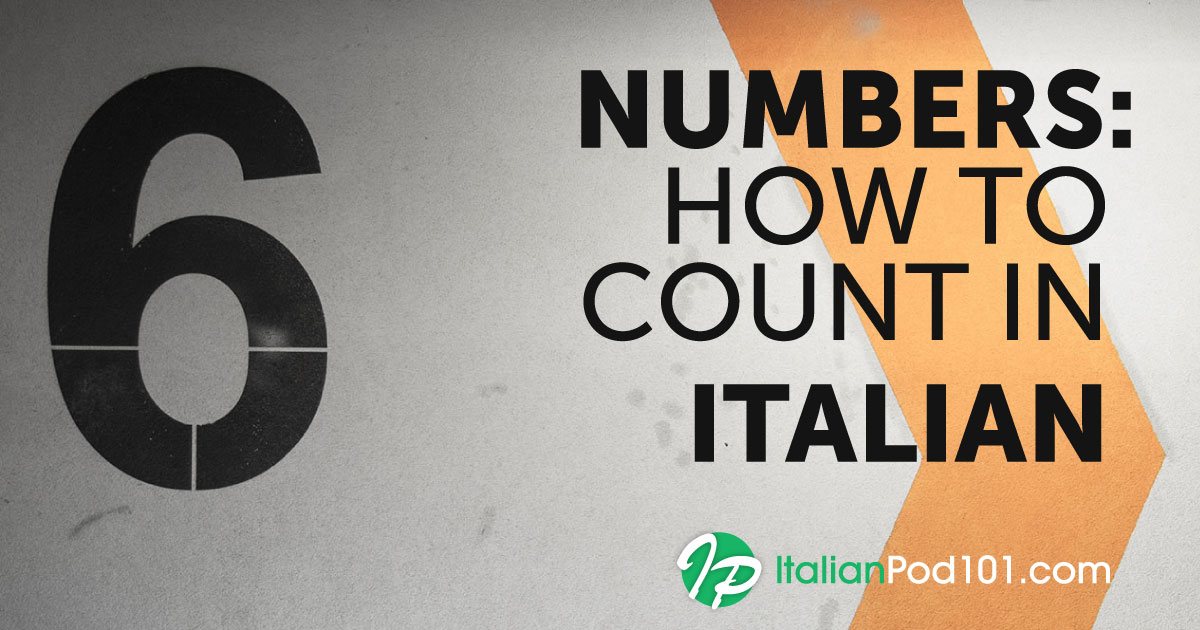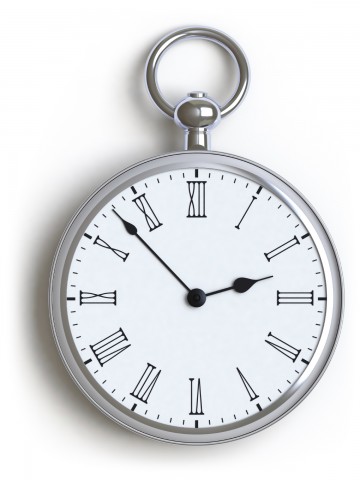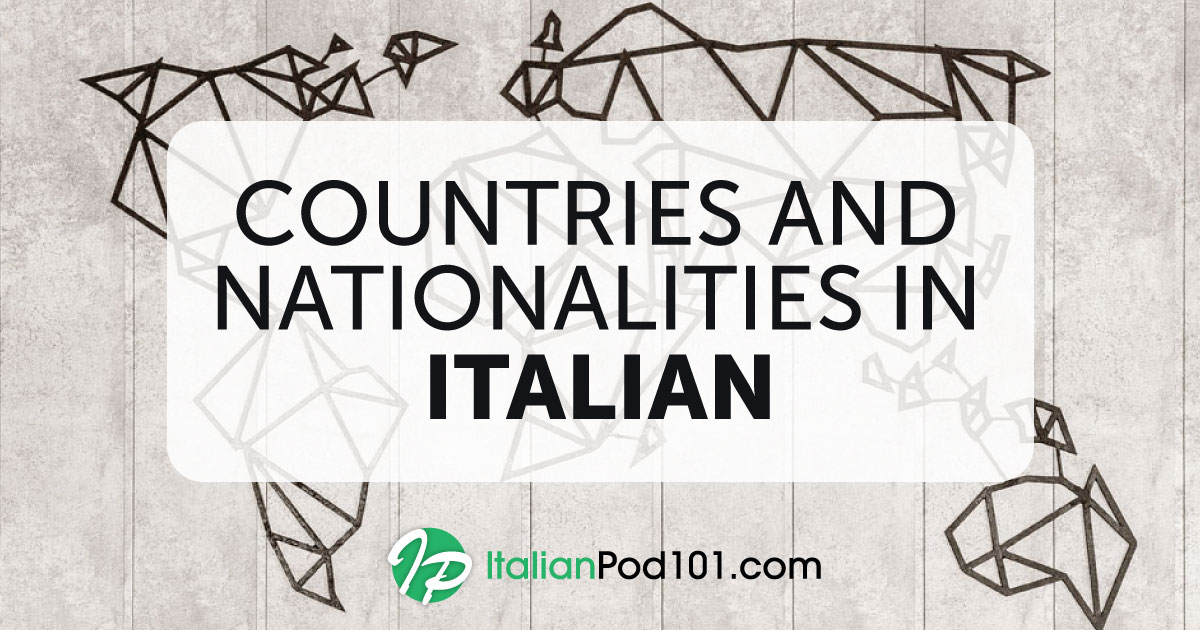Numbers are one of the first things we learn when we’re kids. They seem really simple, right? But while numbers are written the same way in every (Western) language, they’re not only pronounced differently, but also used differently from country to country.
Buying groceries, telling your age, giving your phone number, or letting someone know your home address in Italy. To do any of these basic actions, you’ll need to master Italian numbers. Numbers are everywhere, so you better start practicing them. Don’t forget to check out ItalianPod101.com for a complete lesson on how to master Italian numbers to learn Italian more completely. You can also find complementary info for the numbers in Italian courses.
In the meantime, here’s our numbers in Italian lesson! Learn how to say numbers in Italian and more!
Table of Contents
- Italian Basic Numbers: 0-9
- Italian Numbers 10-99
- Italian Numbers 100-999
- Very Big Italian Numbers. From 1000, Up and Beyond…
- How to Give Your Phone Number in Italian
- Shopping – Saying Prices
- Telling Your Age
- Talking About the Years
- Numbers in Proverbs
- Math Operations
- Conclusion
1. Italian Basic Numbers: 0-9
Let’s start easy. How do you say and pronounce Italian numbers from zero to nine? Here we’ll show you the basic Italian numbers with English translations.
0 – Zero: “Zero”
The spelling “zero” in Italian is the same as in English, but the sound is quite different because the Italian “Z” has a harder sound, more like the sound ds or ts.
Besides its very important use in math operations, the zero is extremely useful for Italian phone numbers, and we’ll see that in a bit.
It’s also useful in some particular expressions, such as Sei uno zero. Watch out, because this isn’t a very nice thing to say to somebody as it literally means “You are a zero,” meaning that the person is nothing, null, or worthless. There’s even a numeric way to say sei uno zero, can you guess how? (You’ll find the answer at the end of the article.)
Note that this is also the name of an Italian comedy radio program.
1 – Uno: “One”
The peculiarity about uno (“one”) is that it’s also an indefinite article, and as such it’s necessary to follow the agreement F/M and change it into un, uno, una when necessary. The rest of the numbers are just straightforward:
2- Due “Two”
3- Tre “Three”
4- Quattro “Four”
5- Cinque “Five”
6- Sei “Six”
7- Sette “Seven”
8- Otto “Eight”
9- Nove “Nine”
2. Italian Numbers 10-99
The Italian numbers from 10 to 19 can be a little tricky to remember because, in order to compose the number, you need to follow two different patterns. Let’s see how these Italian numbers in writing look.
From 10 to 16 the pattern is number + dici, as follows:
11- Undici (uno+dici) “Eleven”
12- Dodici (due+dici) “Twelve”
13- Tredici (tre+dici) “Thirteen”
14- Quattordici (quattro+dici) “Fourteen”
15- Quindici (cinque+dici) “Fifteen”
16- Sedici (sei+dici) “Sixteen”
From 17 to 19 the pattern inverts, and it’s dici + number, as follows:
17- Diciassette (dici+sette) “Seventeen”
18- Diciotto (dici+otto) “Eighteen”
19- Diciannove (dici+nove) “Nineteen”
But there’s no need to worry, because from 20 on, it becomes much simpler. You just put the numbers together with the tens. No spaces and no hyphens.
2- Venti “Twenty”
3- Trenta “Thirty”
4- Quaranta “Forty”
5- Cinquanta “Fifty”
6- Sessanta “Sixty”
7- Settanta “Seventy”
8- Ottanta “Eighty”
9- Novanta “Ninety”
So, for example, for the Italian number 64, we write sessantaquattro (“sixty-four”), 99 is novantanove (“ninety-nine”), etc.
There are just two small rules to keep in mind: 1.) Drop the last vowel in the tens when pairing it with uno (“one”) and otto (“eight”). For example, quarantuno (“forty-one”) and quarantotto (“forty-eight”); 2.) Put an acute accent on the last syllable when pairing any tens with tre (“three”). For example, quarantatré (“forty-three”).
Note that from 40 on, there’s a pattern and the tens always end in –anta. For this reason, when talking about age, it’s common in Italy to say that somebody has “entered, passed, or is in the –anta,” meaning that they’ve passed 40 years of age and have entered the years of maturity. 😉
Oggi entro negli -anta. “Today I am forty.”
3. Italian Numbers 100-999
And finally, we get to 100, cento (“one-hundred”). Note how “one-hundred” is just cento, without the need of un in front. While starting from 200, you just put the number before, and leave cento unvaried. For example:
200- duecento “two-hundred”
300- trecento “three-hundred”
423- trecentoventitrè “three-hundred twenty-three”
518- cinquecentodiciotto “five-hundred and eighteen”
And so on…
Perhaps the most widely known Italian number is 500, because of the legendary car Cinquecento (“Five hundred”). Everybody knows the little rounded car made by FIAT in the ‘60s… But do you actually know why it’s called 500? Two reasons: It had around 500cc of engine capacity and it cost just around 500.000 lire (that is, the Italian currency before the Euro).
4. Very Big Italian Numbers. From 1000, Up and Beyond…
Similar to cento (“one-hundred”) is the behavior of 1000. In Italian, you don’t need to add “one” in front of it. It’s simply mille (“one-thousand”). But note how from 2000 upward, mille becomes mila. This is how it works:
1000- mille “one-thousand”
2000- duemila “two-thousand”
3000- tremila “three-thousand”
4006- quattromila e sei “four-thousand and six”
50.000- cinquanta mila “fifty-thousand”
200.000- duecento mila “two-hundred thousand”
And finally you have the very big numbers:
1.000.000- un milione “one-million”
2.000.000 due milioni “two-millions”
1.000.000.000 un miliardo “one-billion”
3.000.000.000 tre miliardi “three-billions”
And so on…
By now it should be fairly easy to know how to say and write Italian numbers, but there are still a few little differences from English.
For example, while in English for 1100 or 1200 you can say “eleven-hundred” and “twelve-hundred” respectively, in Italian there’s no equivalent for it. Instead, you can only say millecento (“one-thousand one-hundred”) and mille e duecento (“one-thousand and two-hundred”).
Another difference is how Italians say tens, hundreds, and thousands. Here are these Italian numbers in English and Italian.
- Decine “Tens”
- Centinaia “Hundreds”
- Migliaia “Thousands”
C’erano centinaia di persone al Colosseo. “There were hundreds of people at the Colosseum.”
5. How to Give Your Phone Number in Italian
Now that you know the basics of Italian numbers, you can talk to Italians and dive into a few activities that require the use of numbers. For example, exchanging phone numbers. You know, without our phones we are nobody! So you want to be able to give your phone number to Italians and to understand other people’s numbers.
If you’re in Italy, you need to learn about prefisso. This could either be the “area code” or the “international dialing code.”
- Il prefisso dell’Inghilterra è +44. “UK dialing code is +44.”
- Qual è il prefisso di Roma? 06. “What is Rome’s area code? 06.”
Note that only for landlines you need to put the city area code in front of it. And this area code always starts with 0. If you’re calling a mobile phone anywhere in Italy, you don’t need the area code.
6. Shopping – Saying Prices
One of the pleasures of traveling is that of going shopping to buy souvenirs or food. And if you’re in Italy, you can’t miss the experience of walking around a mercatino, a “little market.” In these neighborhood markets, you find delicious fruits, vegetables, cheeses, and much more! They usually appear once a week, early in the morning, and you should ask around about when and where the mercatino near you is.
And now, are you ready to shop? Here are a few useful phrases:
- Quanto costa? Quant’è? “What’s the price? How much is it?”
- Le fragole costano due euro e dieci. “Strawberries cost two euros and ten.”
- Costa/è/viene… these are all synonyms to say “it costs/it’s…”
If saying the numbers in Italian seems complicated, think about how it was before the Euro substituted the Italian Lira. Prices now are much easier to say because they’re not as large as before. Just imagine that a single coffee used to cost around mille lire (“one thousand lira”)! Can you imagine how much a pizza would cost in Lire? And what about a Ferrari?
Al mercato (“At the market”)
7. Telling Your Age
In Italian, to say your age, you say that you have a certain number of years. So, for example:
Ho 24 anni, literally means that you “have 24 years” and not “I’m 24 years old.” To talk about relative age instead, you say that you have more/less years than someone else. Ho due anni più/meno di te literally means “I have two years more/less than you,” meaning that “you are two years younger/older.”
8. Talking About the Years
During a conversation with Italians, you’ll often have to talk about the years. The year we’re on, the year you or somebody else was born, or the year when some specific event occurred. In Italy, you’ll often find yourself involved in a conversation about history and art. So, learning how to talk about the years will be very handy.
Let’s start with the millennium and the year we’re in.
- Siamo nel 2018 “We’re in 2018.” Remember that in Italian you pronounce it duemilae diciotto.
- Era il 2001/Era il duemila e uno. “It was 2001.”
When you want to talk about a decade of the last century in general, you would say gli anni settanta, and you write it this way: gli anni ‘60 (“the sixties”).
- Amo la musica anni ‘80. “I love eighties music.”
- Sono nata negli anni ‘60 . “I was born in the sixties.”
Or, if you want to talk about a specific year, let’s say 1984, you can shorten it and just say ‘84, l’ottantaquattro.
- Ci siamo conosciuti nell’ottantaquattro. “We first met in ‘84.”
- Il ‘96 è stata un’ottima annata per il vino. “‘96 was a very good year for wine.”
And if you want to go back in time, even more, you’ll need to know how to talk about centuries. For this, you need to review ordinal and Roman numbers as this is used to count centuries. (Italian numbers in letters? Yup!)
| Ordinal | Roman | Alternative | ||
|---|---|---|---|---|
| il ventunesimo secolo | XXI | “Twenty-first century” | 2001-2100 | |
| Il ventesimo secolo | XX | Il Novecento | “Twentieth century” | 1901-2000 |
| Il diciannovesimo secolo | XIX | l’Ottocento | “Nineteenth century” | 1801-1900 |
| Il diciottesimo secolo | XVIII | Il Settecento | “Eighteenth century” | 1701-1800 |
| Il diciassettesimo secolo | XVII | Il Seicento | “Seventeenth century” | 1601-1700 |
| Il sedicesimo secolo | XVI | Il Cinquecento | “Sixteenth century” | 1501-1600 |
| etc… |
9. Numbers in Proverbs
Numbers are everywhere in our daily lives and it’s no wonder that they also have a big space in Italian proverbs and common sayings. Here are some of the most common and meaningful:
| Sayings with Numbers | Literal Meaning | Real Meaning |
|---|---|---|
| Non c’è due senza tre | “There’s no two without three” | Good or bad things always come in threes |
| Dare i numeri | “Giving numbers” | Being crazy or confused |
| Costa 4 soldi | “It costs 4 coins” | Being really cheap |
| Sparare a zero | “Shoot to zero” | Insulting or badmouthing somebody |
| Sudare sette camicie | “Sweat seven shirts” | To make a tremendous effort |
10. Math Operations
And last but definitely not least, you’ll need to practice how to talk about simple math operations in Italian.
| + | più | 2 più 2 uguale 4 | “2 plus 2 equals 4” |
| – | meno | 5 meno 2 fa 3 | “5 minus 2 equals 3” |
| x | per | 3 per 2 uguale 6 | “3 times 2 is 6” |
| : | diviso | 6 diviso 3 uguale 2 | “6 divided by 3 equals 2” |
When you’re writing numbers in Italian, there are some other little differences, particularly relative to periods and commas. Italian numbers use the period with thousands and the comma for decimals. For example:
- 1.000 mille “one-thousand” (in English you would write 1,000)
- 1,5 uno virgola cinque “one dot five” (in English you would write 1.5)
And now, as promised… here’s the answer on how to say sei uno zero in numbers: 610 (sei [6] uno [1] zero [0]). Clever, right?
11. Conclusion
Have you enjoyed discovering all about Italian numbers? I’m sure that you’re now ready to tackle phone numbers, addresses, prices, and numbers up to a miliardo (“billion”). Hopefully you’ve also learned a little bit about numbers in Italian grammar.
But if you want to keep having fun learning Italian, don’t miss out on all the material available on ItalianPod101.com.
This includes helpful, relevant, and free vocabulary lists, as well as our MyTeacher program, which allows you to have one-on-one guidance as you delve into the Italian language and culture.
You deserve to have the best Italian-learning experience, and ItalianPod101.com has your back!















